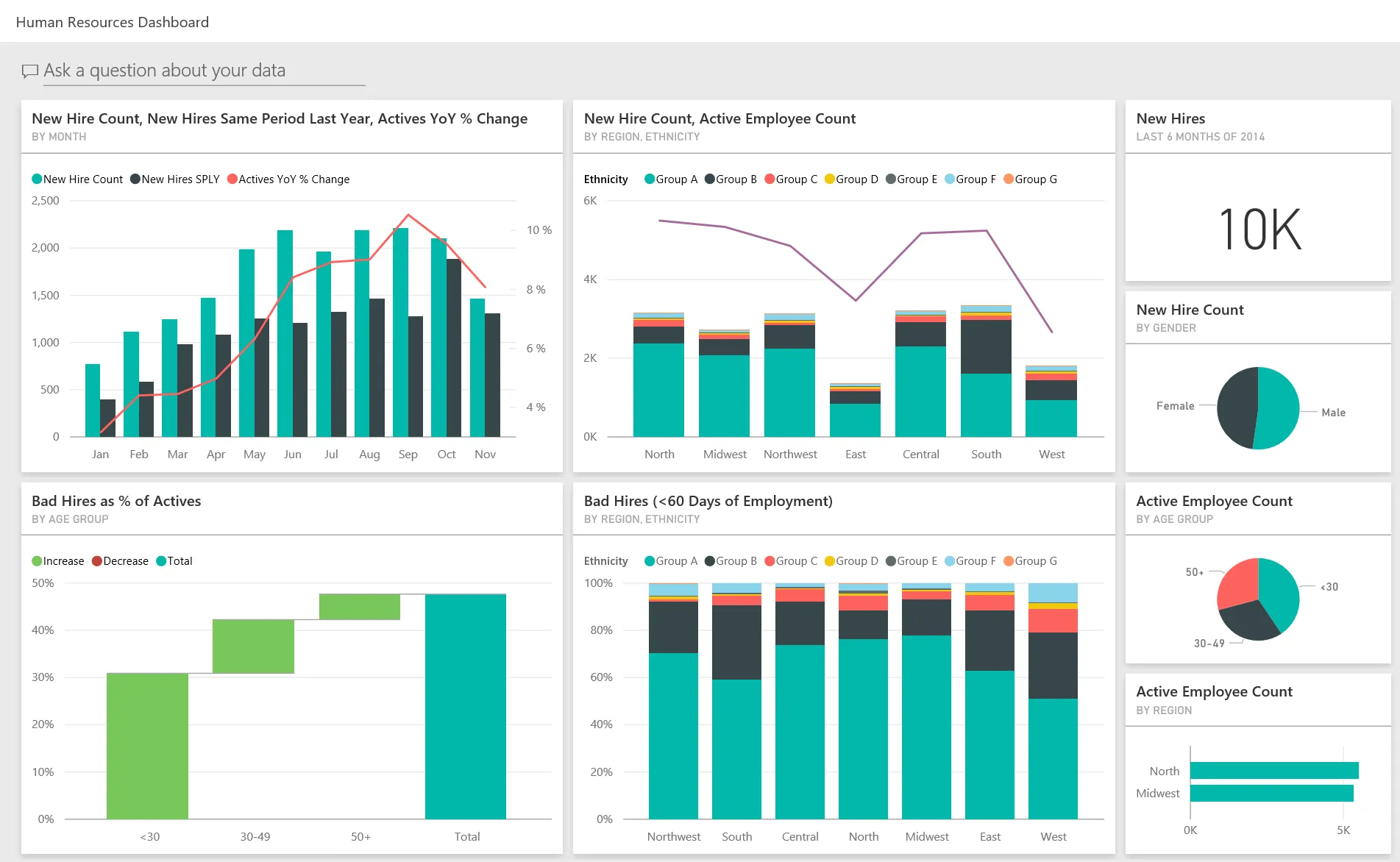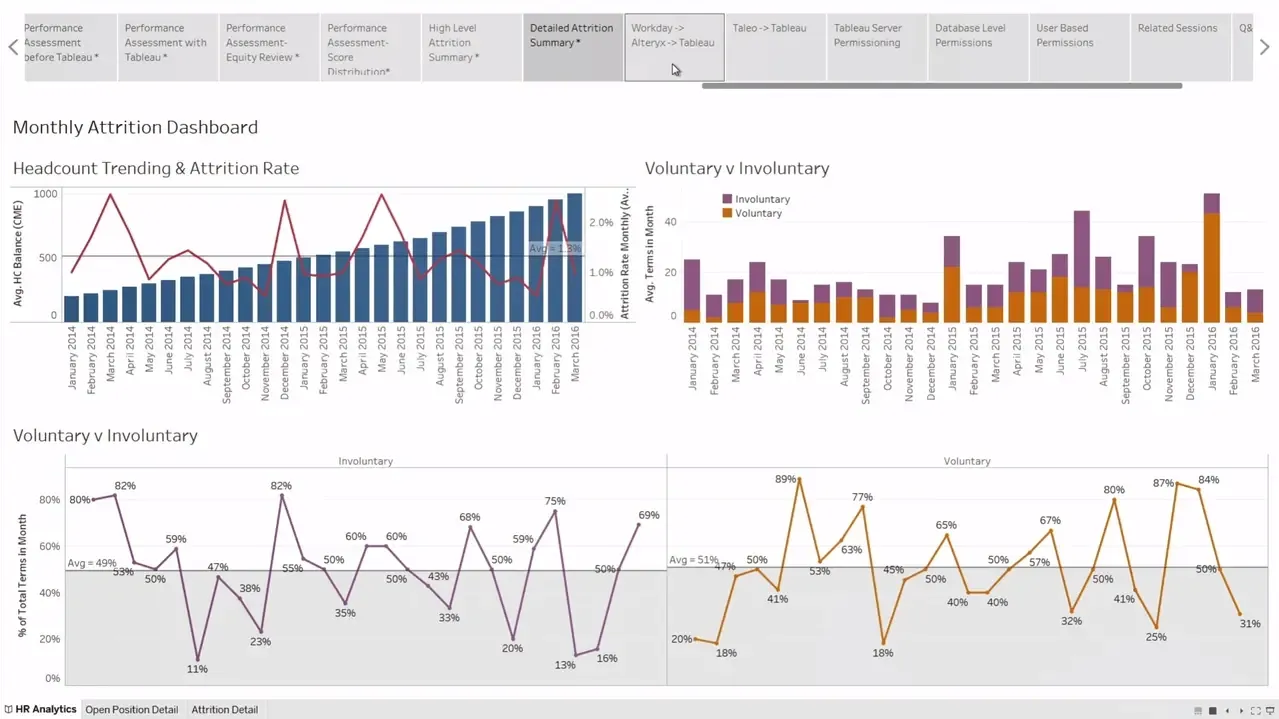Services
SERVICES
SOLUTIONS
TECHNOLOGIES
Industries
Insights
TRENDING TOPICS
INDUSTRY-RELATED TOPICS
OUR EXPERTS

February 28, 2025
HRs are responsible for maintaining an organization's workforce, preventing employee shortages or overstaffing. Predictive analytics can help HR specialists forecast an organization's talent requirements and workforce needs well in advance to timely address them. This enables HR leaders to make better hiring decisions, ensuring the availability of skilled personnel exactly when and where they're needed to support the company’s business outcomes.
AI-based predictive analytics offers more proactive methods for identifying prospective employees. When companies cast an initial net for possible job candidates, predictive analytics tools can analyze numerous factors, including education, skills, experience, and relevant domain expertise, to forecast their future performance. This way, comprehensive analytics insights help HRs streamline candidate sourcing and spend less time rejecting unsuitable job-seekers.
Moreover, such systems can help reduce hiring costs as AI-enabled models can process enormous amounts of potential employee data, meaning that companies need to allocate fewer human resources to these tasks.
Predictive analytics models can help create more accurate HR budgets by providing data-driven insights and projections based on particular market trends, employee turnover, and company growth objectives.
Predictive analytics can also facilitate compensation planning by helping HR departments analyze industry salary benchmarks and forecast potential wage growth to keep the company's compensation packages competitive. Furthermore, predictive models can suggest appropriate salary ranges for various positions, taking into account employees' experience and performance, the current market conditions, and a company's business goals.
HR predictive analytics helps employees meet their performance goals and overall corporate objectives. For example, HR specialists can leverage predictive models to understand how different factors, such as employee incentive schemes, will positively or negatively impact different team members' performance. Furthermore, they help monitor workforce performance data to identify potential skill gaps and recommend targeted employee development initiatives.
Scheme title: K-Means cluster analysis of employee performance
Data source: semanticscholar.org — Employee’s Performance Analysis and Prediction Using K-means Clustering
& Decision Tree Algorithm
Instead of hiring new specialists and managers from the outside, HRs can use predictive analysis to identify top talents and potential leaders in-house. By analyzing employee experience, past career trajectories, skill sets, and competency upgrades, predictive analytics models can help HRs spot employees with the potential to become managers and occupy leadership positions within an organization. Based on these insights, HR specialists can build succession plans to prepare the best employees for future career development.
HR departments can struggle to timely identify employees at a high risk of leaving the company. Beyond analyzing employee KPIs based on performance reviews, predictive analytics systems can factor in sentiment and satisfaction data collected through engagement surveys, as well as career development milestones. Based on these data sources, predictive analytics models can provide highly accurate insights about employees at risk of resigning.
If spotted in due time, HR can mitigate the flight risk and take proactive measures to motivate employees to stay, using targeted retention techniques and personalized consultations. Timely analysis of attrition rates will help companies cut down employee turnover by adjusting their HR strategies.
Power BI is a business intelligence and data visualization solution by Microsoft comprising a desktop
application, a SaaS solution, and mobile apps for Android, iOS, and Windows.
Often combined with Microsoft Fabric, which provides additional data engineering and machine learning modeling
features, Power BI enables HR managers to perform predictive people analytics and visualize the resulting insights.
For instance, the platform can be used to predict employee attrition and churn.

Image title: An HR dashboard in Power BI
Image source: Microsoft
Tableau is a BI, data analytics, and visualization platform by Salesforce. The solution integrates
seamlessly with Einstein, Salesforce’s built-in AI, giving users access to advanced predictive capabilities
powered by machine learning models, including linear regression.
HR professionals can leverage Tableau in a variety of people analytics use cases, such as candidate assessment
or employee attrition and turnover prediction. These forecasts and other insights can be visualized via HR dashboards
for easier data interpretation and sharing.

Image title: An employee attrition analytics dashboard in Tableau
Image source: Tableau
The Utah-based HR tech company HireVue performs text analysis on candidate interviews, combined with various
other signifiers of suitability developed by the company's psychological research teams.
The company uses proprietary machine learning models that analyze video-based interviews to predict the candidate’s
future job performance. Most interestingly, the platform can assess non-verbal cues like facial expressions,
eye movements, body language, and even personal style to enable companies much deeper insight into a candidate's
personality than any other form of an interview. HireVue’s clients include Deloitte, Goldman Sachs, Amazon, and
Unilever. For example, using the HireVue platform, Unilever achieved a 90% faster hiring process, resulting in
£1m of annual cost savings.

by predicting future resource needs and hiring or retraining employees accordingly.
by identifying the most suitable candidates for an open position based on personal data.
by partially automating and speeding up the recruiting process and preventing resignations that would require new hires.
management by identifying skill gaps and establishing targeted training or other upskilling initiatives.
by offering competitive salaries aligned with the job market and fostering internal succession.
by timely addressing signs of attrition and boosting their motivation with rewards and incentives.
Market & investments | |
|---|---|
| The HR analytics market size is estimated at $4.87 billion in 2025 and is expected to reach $8.92 billion by 2030. Key factors driving the market's expansion include the analytics’ ability to make predictions about employee performance, retention, and recruiting. | |
| From mid-2020 to mid-2023, people analytics functions grew by an average of 43% , demonstrating the commitment of global organizations to making more informed, data-driven decisions. | |
| The average organization currently uses 2.3 different HR analytics and planning solutions to meet their needs. Key software selection factors include automated reporting, data importing and exporting, accessible benchmarking data sets, ease of use, and intelligent features such as forecasting and modeling. |
Scheme title: HR analytics solution adoption among enterprises
Data source: Sapient Insights Group
Use cases & benefits | |
|---|---|
| 57% of HR professionals surveyed believe that career progression and hiring will be heavily influenced by data analytics. | |
| Currently, 25% of HR departments use AI. Among them, AI is mostly used for talent acquisition (42%), employee training and development (36%), and people analytics (21%). | |
| Despite the growing volume of data available for HR, only 21% of HR leaders believe their organizations are effectively using talent data and analytics to shape talent acquisition and recruiting strategies, improve employee engagement, or drive other business decisions. | |
| People analytics can help increase recruiting efficiency by 80% and business productivity by 25% while reducing employee attrition rates by 50%. |
Predictive analytics streamlines decision-making within HR departments. So how to implement it properly to process vast volumes of HR data, enhance employee engagement, and improve your business's bottom line? Here are the top 3 principles to consider:
Data is the cornerstone for the accuracy of a predictive analytics tool. You can always start building a predictive analytics model by leveraging in-house historical data, containing years' worth of reports and logs to analyze. However, you should ensure the data is accurate and consistent. Depending on the data quality, you should be ready to gather additional data or even start gathering brand new data sets to make sure your predictive analytics model gives you accurate insights.
That said, it's not always necessary to train a large, curated corpus of data to run machine learning-based predictive analytics. So long as your data set is consistent and old enough to yield meaningful year-on-year statistical trends, it will suit the majority of companies.
HR predictive analytics systems should focus on relevant metrics. Depending on the business objectives, HR predictive analytics adopters should develop meaningful benchmarks of success, meeting which can positively impact the company. For example, you can measure the profit growth percentage or increase in sales after investing in training your sales representatives.
Certain industries have intrinsic metrics (such as social media shares obtained in PR organizations, traffic fluctuations in SEO operations, or units produced in industrial settings) that can be input into an employee's predictive analytics profile. But where productivity is more subjective, companies would need to make an effort to implement other accurate metrics.
The most popular algorithms for HR predictive analytics currently include decision trees-based algorithms and transformer neural networks. Decision trees are classification algorithms that map future outcomes as branches, generating intuitive graphs to facilitate decision-making. Transformers, on the other hand, are excellent at identifying relationships between sequential data points, making them a good option for time series analysis.
Challenge | Solution | |
|---|---|---|
Talent shortage |
When trying to implement predictive analytics, the majority of HR departments in companies face a lack of
skilled talent. While most applications of predictive analytics in HR are user-friendly, they call for
substantial data analysis skills that aren’t commonly found in HR teams.
| Adopting a predictive analytics solution and other AI tools in the workplace, you deal with two aspects, you deal with two aspects: technical implementation and changes in business processes. First, depending on your goals and available budget, you can either hire internal technical specialists or trust the implementation of a predictive analytics solution to external predictive analytics and machine-learning experts who can help you implement and tune the predictive analytics model. Anyway, to realize the full potential of the technology for your human resource management practice, you should invest in HR specialists' training to facilitate the adoption process and guarantee the system's smooth operation. |
Insufficient IT resources |
Running predictive analytics in HR is a very demanding process from the IT perspective. Smaller companies
with limited IT expertise and infrastructures will have the hardest time implementing these analytics
programs at scale.
| Outsourcing the implementation of a predictive analytics solution into your HR practice can be a viable option. A reliable partner will help you choose an out-of-the-box SaaS solution and customize it or build a fully custom system according to your particular business objectives. Furthermore, SaaS platforms provide managed services and scalable cloud computing resources which eliminate the burden of maintaining a complex IT infrastructure and simplify the adoption process. |
Regulatory compliance & privacy |
Predictive analytics can raise a number of regulatory challenges regarding data privacy, bias, and employee
monitoring.
| From a legal standpoint, it's essential to stay on top of the turbulent regulatory environment surrounding employees' rights regarding workplace monitoring and AI systems and, if necessary, to take professional advice about protecting the company from legal exposure. However, to eliminate the risk of regulatory compliance issues, predictive analytics models usually use obfuscated data for training and delivering predictions, guaranteeing personal and sensitive data safety. |

Itransition’s consultants can assist you with every step of predictive HR analytics software implementation, including business analysis, data audit, solution conceptualization, project planning and execution, and user adoption.
Itransition helps you implement predictive analytics systems aligned with your unique HR needs, taking care of software design, custom development or platform customization, integration, testing, and deployment to production.

Predictive analytics solutions have proven to be an excellent addition to the digital toolkit of recruiters and talent managers. By enabling a more data-driven and proactive approach to workforce planning, they help HR specialists build and maintain highly successful talent pools to meet their organizations’ current and future business goals.
To seamlessly implement predictive analytics into your human resource management practices, team up with an experienced IT partner like Itransition.
Just like data analytics as a whole, HR analytics solutions can be divided into four categories based on its purpose and capabilities:
describes events that occurred in the past, such as employee turnover during the year.
investigates the reasons behind a certain trend or event, such as the relationship between employee turnover rates and attrition.
helps forecast upcoming trends or scenarios, for instance, by identifying employees at risk of leaving.
provides recommendations on the best course of action, including offering benefits and promotions to prevent an employee from leaving.
Human resources departments can count on a wide choice of data analytics solutions with predictive capabilities available on the market. These include popular, industry-agnostic solutions typically offered by major cloud services providers, such as Microsoft Power BI, Tableau, and IBM Cognos Analytics. Alternatively, organizations can implement more specialized tools for HR data analytics, including Visier and Workday.
Prioritize platforms offering user-friendly data analytics features and interfaces, such as self-service data preparation, guided ML model building, and intuitive dashboards. Other factors to consider include the platform’s integration capabilities, security features, compliance with applicable regulations, scalability, and total cost of ownership (covering implementation budget, licensing fees, etc.). You can also check out user feedback on popular peer-to-peer review platforms like G2, Capterra, and Gartner Peer Insights.

Insights
Explore common AI use cases, technologies, trends, examples, and popular platforms in HR, along with useful tips to address common adoption challenges.

Service
Itransition delivers HR software solutions to help companies eliminate administrative burden, maintain regulatory compliance, and improve employee engagement.

Service
Itransition offers full-scale data analytics services to help companies turn raw data into actionable business insights, fostering informed decision-making.

Case study
Read this case study about Itransition’s project for a US university research center to deliver job search app testing and two custom web portals.

Insights
Explore top predictive analytics tools and an end-to-end guide for choosing the best one for your company to unlock deeper insights and drive business growth.

Case study
Learn how Itransition developed an RPA bot that automates addition of new candidates to the HRM, significantly increasing process efficiency and reliability.